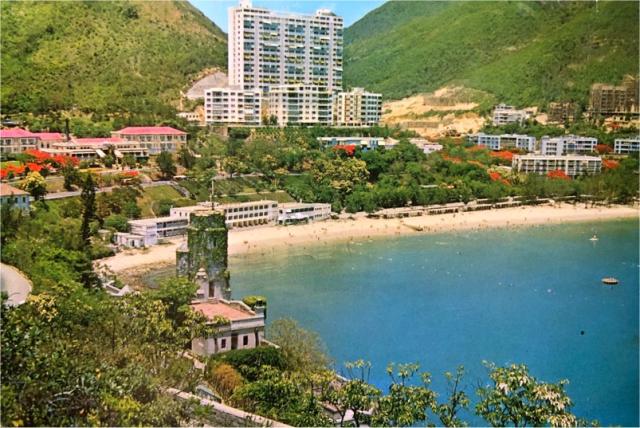The description on the message side of this postcard purchased new in 1970 reads: Repulse Bay – a summer resort.
Photo by S.C. Moy.
According to selected extracts from A Touristic Guide to Hong Kong, “Repulse Bay Beach is a popular resort. Of all the bays and inlets that indent the coast of Hong Kong Island, Repulse Bay is the most picturesque. Enclosed on three sides by green-clad hills, the bay laps the shore on a wide expanse of fine sand along a crescent-shaped beach. Known as ‘Shallow Water Bay’ (淺水灣) to the local people, Repulse Bay and its beach are a very popular seaside resort. One of the most charming spots in Hong Kong, Repulse Bay Beach has been called the Waikiki of Hong Kong. Although the two beaches are equally well known, Repulse Bay Beach is smaller and prettier, but without the rolling surf that exists at Waikiki. Repulse Bay Beach is fringed at one end with Flame of the Forest trees, whose bright red flowers in early summer form a flaming canopy over the pale gold-coloured coast. At Repulse Bay the hibiscus is almost a perennial, blooming virtually the whole year round. The profuse inflorescence of wild plants, the beach with its fine sand, the sheltered nature of the bay’s topography, the attractiveness of the settings – all these conspire to make Repulse Bay a ‘natural’ as a resort.” The aforementioned 1968 publication was compiled and edited by Mr Edward Y. Hsu in collaboration with the Department of Extra-Mural Studies, Chinese University of Hong Kong.
A late 1930’s sunset at Repulse Bay is prettily observed by Ellen Thorbecke in her book Hong Kong, Kelly & Walsh Ltd., Hong Kong n.d. (1938?): “At Repulse Bay, the sunset is a spectacle unforgettable for everyone who has eyes to admire and a heart to feel the blessing of so much beauty. The hills turn purple and the sea becomes burning red under the last rays of the sun. Slowly all light extinguishes and darkness sooths the passionate tint of the landscape into perfect rest. One by one, the stars blinkingly appear, and on the water fishing boats burn their carbide lamps in order to attract the fish by their powerful lights. Heaven and sea seem equally illuminated, while hills and seashore quietly fall asleep under the protective blackness of the night.”
